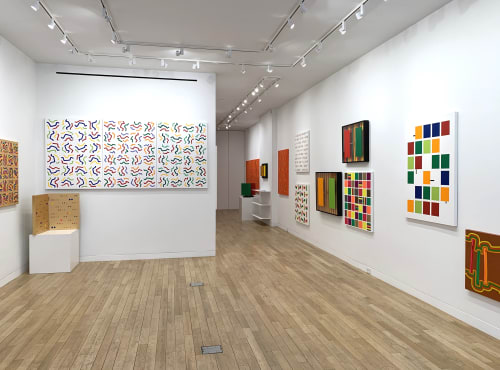February 28, 2022 / East Side Feed / Arts & Entertainment
“Kaleidoscope,” a collection of works by Italian artist Osvaldo Mariscotti, recently launched as the first exhibit at Upsilon Gallery’s new location at 23 East 67th Street. Stationed within an intimate third floor walkup, the cozy exhibition space positions Mr. Mariscotti’s pictures in a way which further encourages his work’s playful perspective. The colorful paintings are sometimes hung above and below one another, almost bouncing up and down across the pristine white walls, like the colorful organism-shapes inhabiting Mariscotti’s canvases.
These collected works direct our thoughts to geniuses of past generations (think structures of Mondrian and Stella, pulsating like Rothko, while occasionally borrowing ideas and aesthetics from Warhol and Klimt). Mr. Mariscotti’s are lines and squares and circles, illuminated by childlike color, floating on canvases of white, red, gold and black.
Take the time to examine this unique collection and soon their colorful vibrations radiate beyond the canvas, triggering our sensations and provoking primordial meaning. The playful shapes, childlike colors, and overall cleanliness contradict left over pencil lines. We contemplate eternal order and fate through a clear biological lens, while regularly confronted by an image of the artist, as draftsman, at work.
The exhibit propels us forward and we engage with obsessive, but playful, examinations of scale. Like gazing through the titular instrument, “Kaleidoscope” acutely defines our experience. Each new canvas offers a fresh rotation and the shapes you observed moments before are rearranged or replaced by some new configuration. You feel as though you’re peering through a microscope at various magnifications, observing small, single cell organisms, perfectly dispersed, captured in moments of magnetic harmony with one another.
Upon entering or leaving the gallery, we encounter a red tryptic. Green, blue, and yellow electronic organisms are magnified and float atop a flat, matted surface. Their simple shaped cellular structure bursting with the most supercharged green radiation you’ve ever seen in a picture, made even more iridescent by contrasting its flat vermillion backdrop. The second canvas, attached to its right, composed of the same vermillion, is blank and impenetrable. The blue and green and yellow shapes are absent, and the canvas’ very existence neutralizes our experience momentarily. Nothing to see here. Like the empty space between the frames of a film, it functions to transition our thought from one point to the next. Here it separates our first experience from our third. The third canvas appears as an apparent magnification of the first — perhaps not the same objects, but the same culture. Again, vibrating with those same electronic green and blue lines. Among the three, the center canvas, half the size of the others, remains totally inactive, reminding us that we are actively passing through time, making the decision to observe scale. Two magnifications examining the same petri dish.
Jerry Saltz once called Mark Rothko’s work “Buddhist Television” because of the effect his paintings have on the eyes and spirit of the viewer. Mr. Mariscotti’s work is not totally dissimilar from the experience of Rothko. Not as grand, but not nearly as painful or pessimistic. Watching his work, we see color dissolve from childhood reds and blues and yellows into dark red-browns, blacks and grays. The shapes remain but we feel decay and claustrophobia and the inevitable departure of life within structure. Unlike Rothko, where his art’s result often plunges us deeper into horror, or sometimes resilience, Mariscotti’s work enlists humor and charm and playfulness in our confrontation with fate, despite acknowledging our shared, slow, creeping, inevitable expiration date. Balancing both poles of existence — childhood joy and our impending lifeless end, Mariscotti reminds us that no matter how good or bad something may seem, the other experience resides nearby.
“Kaleidoscope” will be on display until April 16.
Upsilon Gallery’s exhibition hours are Monday to Friday, 10am-6pm, and by appointment on Saturdays.
Upcoming exhibitions will feature artists including Clyde Hopkins, Diet Sayler and Williard Boepple.
For more information, please visit upsilogallery.com.

